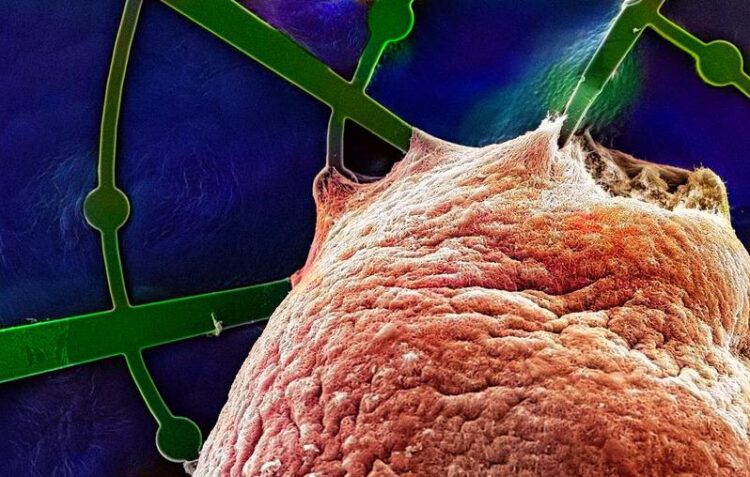Hammock for brain organoids

A human brain organoid (colored red) grew on the hammock-like mesh structure of a Mesh-MEA (green) for one year. The scanning electron micrograph shows how the brain organoid has grown around the mesh filaments and microelectrodes.
(c) Max Planck Institute for Molecular Biomedicine
Novel microelectrode array system enables long-term cultivation and electrophysiological analyses.
Brain organoids are self-organizing tissue cultures grown from patient cell-derived induced pluripotent stem cells. They form tissue structures that resemble the brain in vivo in many ways. This makes brain organoids interesting for studying both normal brain development and for the development of neurological diseases.
However, organoids have been poorly studied in terms of neuronal activity, as measured by electrical signals from the cells. A team of scientists led by Dr. Thomas Rauen from the Max Planck Institute for Molecular Biomedicine in Münster, Germany, in collaboration with Dr. Peter Jones’ group at the NMI (Natural and Medical Sciences Institute at the University of Tübingen, Germany), has now developed a novel microelectrode array system (Mesh-MEA) that not only provides optimal growth conditions for human brain organoids, but also allows non-invasive electrophysiological measurements throughout the entire growth period. This opens up new perspectives for the study of various brain diseases and the development of new therapeutic approaches.
Nerve cells communicate through chemical signals (neurotransmitters), which are converted into electrical signals that pass information from one nerve cell to the next. This is also the way in which the neurons in the brain organoids communicate with each other.
“To find the causes of various brain diseases and new therapeutic approaches, it is not enough to simply look at nerve cells under the microscope. You also need to know how the nerve cells work – how they communicate with each other,” says Thomas Rauen. However, current systems for recording the communication between nerve cells in brain organoids have their limitations. In the relatively large brain organoids, the sensors either do not get close enough to the nerve cells or they destroy parts of the organoid tissue when they penetrate it.
*A hammock for brain organoids*
Now, Dr. Thomas Rauen’s team, in collaboration with Dr. Peter Jones’ team, has developed a novel microelectrode array system (Mesh-MEA) that not only provides optimal growth conditions for human brain organoids, but also enables non-invasive electrophysiological measurements throughout the growth period of the brain organoids.
The scientists designed a kind of hammock for the brain organoids: “The hammock-like mesh structure provides 61 microelectrodes for electrophysiological measurements of neuronal network activity,” explains Dr. Peter Jones.
The current study shows that brain organoids can not only be cultured on the newly developed Mesh MEA for up to one year but can also be continuously electrophysiologically analyzed during this period. “This is a great achievement because it allows us to study brain organoids for much longer than before. Normal human brain development takes a very long time, and neurodegenerative diseases also develop slowly,” says Rauen.
The key to the current success is that the brain organoids enveloped the filaments and continued to grow on the spider web-like Mesh-MEA scaffold. Dr. Katherina Psathaki from CellNanOs at the University of Osnabrück was able to show this using an electron microscope. She analyzed brain organoids in their Mesh-MEA hammock one year after the start of cultivation. The images clearly confirm that the brain organoids develop in the suspended Mesh-MEA net structure. The microelectrodes are located in the center of the brain organoid tissue,” adds Thomas Rauen.
The scientists observed spontaneous neuronal activity recorded by the microelectrodes in the brain organoids. “There was continuously recurring, synchronized neuronal activity throughout the recording phase, suggesting the formation of neuronal networks as seen in vivo,” says Thomas Rauen.
Although brain organoids cannot represent all the functions of the human brain, Peter Jones and Thomas Rauen are convinced that the electrophysiological analysis of brain organoids using their newly developed Mesh-MEA system will open up the possibility of simulating specific functional aspects of human brain development and its diseases in the laboratory, which has not been possible until now.
The project is funded by the Max Planck Society (Project Group White Paper – Animal Experiments in the Max Planck Society – Brain Organoids: Alternatives to Animal Testing).
Wissenschaftliche Ansprechpartner:
Dr. Thomas Rauen: thomas.rauen@mpi-muenster.mpg.de
Originalpublikation:
Matthew McDonald, David Sebinger, Lisa Brauns, Laura Gonzalez-Cano, Yotam Menuchin-Lasowski, Michael Mierzejewski, Olympia-Ekaterini Psathaki, Angelika Stumpf, Jenny Wickham, Thomas Rauen, Hans Schöler, Peter D. Jones
A mesh microelectrode array for non-invasive electrophysiology within neural organoids
Biosensors and Bioelectronics, Volume 228, 15 May 2023, 115223
https://doi.org/10.1016/j.bios.2023.115223
Weitere Informationen:
https://www.mpi-muenster.mpg.de/722428/20230412-mesh-mea Hammock for brain organoids: Press release on the website of the Max Planck Institute
https://www.nmi.de/de/pharma-und-biotech/projekte/detail/drephos/ Information on the ongoing project “DREPHOS” (Three-dimensional Electrophysiological and Optogenetic Systems), in which the NMI has already generated the knowledge required for the development of three-dimensional MEAs.
Media Contact
All latest news from the category: Life Sciences and Chemistry
Articles and reports from the Life Sciences and chemistry area deal with applied and basic research into modern biology, chemistry and human medicine.
Valuable information can be found on a range of life sciences fields including bacteriology, biochemistry, bionics, bioinformatics, biophysics, biotechnology, genetics, geobotany, human biology, marine biology, microbiology, molecular biology, cellular biology, zoology, bioinorganic chemistry, microchemistry and environmental chemistry.
Newest articles

First-of-its-kind study uses remote sensing to monitor plastic debris in rivers and lakes
Remote sensing creates a cost-effective solution to monitoring plastic pollution. A first-of-its-kind study from researchers at the University of Minnesota Twin Cities shows how remote sensing can help monitor and…

Laser-based artificial neuron mimics nerve cell functions at lightning speed
With a processing speed a billion times faster than nature, chip-based laser neuron could help advance AI tasks such as pattern recognition and sequence prediction. Researchers have developed a laser-based…

Optimising the processing of plastic waste
Just one look in the yellow bin reveals a colourful jumble of different types of plastic. However, the purer and more uniform plastic waste is, the easier it is to…



